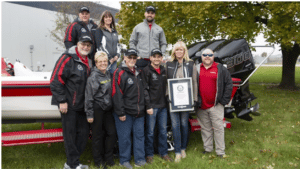Many owners of personal watercraft (PWC) such as Jet Skis, Sea-Doos and WaveRunners consider these fun little vessels to be “water toys” rather than boats. In some cases, this can lead to the misconception that their homeowner’s insurance policy also covers their PWC.
“That’s not the case. You need separate insurance coverage for your personal watercraft,” said Chris McKinnon, manager, Sea Insure® presented by Sea Tow. “That’s why we recently introduced a new Sea Insure PWC Policy, so Sea Tow Members can protect the often sizeable investment they have made in their PWCs.”
The new Sea Insure PWC Policy is similar to Sea Insure’s standard boat insurance policy in that it covers the craft for loss, theft, hull damage and liability, providing owners with peace of mind. Sea Insure PWC coverage also is offered at highly competitive rates.
“Sea Insure coverage is exclusively available to Sea Tow members, but it only takes a few minutes to join Sea Tow online or at your local Sea Tow operation, and membership comes with free towing and a wealth of other benefits both on and off the water,” McKinnon said.
Like motorcycles versus cars, PWCs do not offer the same level of protection as boats, and riders can face unique challenges when operating their craft. With this in mind, Sea Insure offers the following safety tips to help PWC riders of all experience levels stay safe on the water.
10 PWC Safety Tips from Sea Insure
1. Always wear a U.S. Coast Guard-approved life jacket when on a PWC. Many states require that every PWC rider wear a life jacket, including passengers. However, even in states where it’s not required, be sure that you and your passengers wear life jackets anyway. It could save your life or the life of a family member or friend.
2. There’s a far greater chance that the driver will fall off a PWC than a boat, so it’s an absolute “must” for the driver to attach a kill-switch lanyard to the ignition and to his or her wrist or wetsuit. If the driver falls off, the lanyard disconnects and the PWC’s engine shuts down, allowing for re-boarding and preventing a runaway PWC.
3. Keep your distance from other vessels. This includes other personal watercraft.
4. Do not use waves and the wakes made by boats as ramps for jumps. Limited vision may cause an accident with another boat coming the opposite way.
5. Never operate a PWC if you have consumed alcohol or other drugs. Impaired operators can cause accidents and may face legal charges.
6. Do not drive a PWC unless you have reached the legal age. In some states the minimum age is 11 years old to operate a PWC, in other states it is 16. Check your state’s regulations.
7. If you are operating a PWC in cold water, consider wearing a wetsuit. It will help prevent the risk of hypothermia, particularly if you fall off or jump into the water.
8. Be sure to wear sunscreen and bring along bottled water to prevent dehydration. Most PWCs have a storage compartment where you can store water and snacks.
9. It’s a good idea to bring some form of ID and money along as well. While riders frequently jump aboard their PWC without a wallet, shoes, shorts or cover-up and take off, it’s best to be prepared in case unexpected circumstances arise.
10. Riding a PWC before sunrise or after sunset is strictly prohibited by law in most areas. So before the sun goes down, it’s time to head back to the shore.









